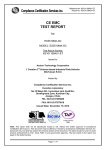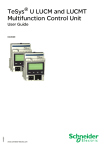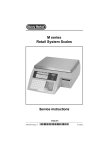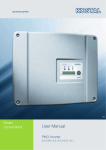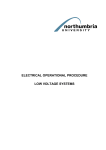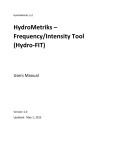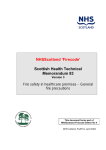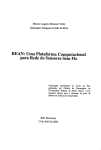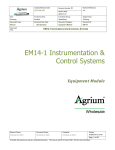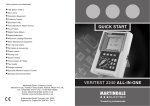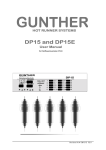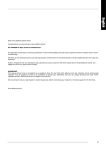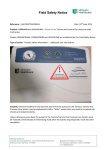Download Low Voltage Electrical Safety Policy - Library
Transcript
UNIVERSITY HOSPITALS LEICESTER NHS TRUST DIRECTORATE OF FACILITIES LOW VOLTAGE ELECTRICAL SAFETY OPERATIONAL POLICY Including ELECTRICAL SAFETY RULES & LOCAL RULES FOR WORK ACTIVITIES ON LOW VOLTAGE SYSTEMS AND EQUIPMENT (HTM 2020) & STAFF GUIDANCE FOR PORTABLE ELECTRICAL APPLIANCE SAFETY APPROVED BY: Policy & Guideline Committee TRUST REF: B27/2006 DATE APPROVED: 10 July 2006 POLICY CO-ORDINATOR: Glyn Lambley Senior Statutory Compliance Manager REVIEW DATE: July 2007 CONTENTS SECTION 1 - ELECTRICAL SAFETY POLICY INCLUDING ELECTRICAL SAFETY RULES Definitions Part 1. Policy Statement Part 2. Definitions Part 3. Responsibilities 3.1 Employer / Management Responsibilities 3.1.1 3.1.2 3.1.3 3.1.4 3.1.5 3.2 Compliance with Statutes Managerial Responsibilities for Electrical Systems Temporary Electrical Installations Personnel Appointment of Duty Holders Employee Responsibilities Part 4. Electrical Safety Arrangements 4.1 Electrical Safety Rules for all Employees 4.2 Electrical Safety for Portable Electrical Equipment 4.3 Authorisation 4.4 Safe Working Procedures 4.4.1 4.4.2 4.4.3 4.4.4 4.4.5 4.4.6 4.4.7 Work Activities Protective Equipment Cutting off Electrical Supplies Cutting off Supply Isolation Safe Working Systems Live Working 4.5 Safety Documents 4.6 Contractors Working on Trust Sites 4.7 Generating Plant and Batteries 4.7.1 4.7.2 4.7.3 4.8 Work on Generating Plant Commissioning of mobile Generating Plant Work on Batteries Underground Cables and Overhead Lines 4.8.1 4.8.2 Work on Cables Overhead Lines Pages 1 - 37 4.9 Portable Electrical Equipment 4.9.1 4.9.2 4.9.3 4.9.4 4.9.5 Recording Flexible Power Supply Cables Mains Operated Portable Equipment used outside the building Regular Plant Inspection and Testing Hazardous Areas Part 5. Fire Protection Equipment for Electrical Equipment 5.1 5.2 5.3 Fixed Automatic Equipment Portable Extinguishers General Part 6. List of Supporting Documents APPENDICES Appendix 1 Duty Holders Appendix 2 Service Isolation – Safe to Work Permit Appendix 3 Form of Completion and Inspection Certificate Appendix 4 Schedule of Inspection and Test Results Appendix 5 Portable Equipment, Inspection and Test Record SECTION 2 - LOCAL HOUSE RULES SECTION 3 - STAFF GUIDANCE FOR PORTABLE ELECTRICAL APPLIANCES SECTION 1 - ELECTRICAL SAFETY POLICY (INCLUDING ELECTRICAL SAFETY RULES) Part 1 Policy Statement The University Hospitals Leicester NHS Trust is committed to providing for the safe operation and maintenance of the electrical systems, to monitor this policy, to ensure its effectiveness, and ensure all electrical systems are managed without giving rise to danger. This Electrical Safety Policy has been made for the protection of those persons, whose employment involves them using or carrying out work on University Hospitals Leicester NHS Trust electrical systems and equipment and any person, who may be affected by the activities of all employees of the trust. This policy is in accordance with the requirement of :The Health and Safety at Work etc. Act 1974 and, The Electricity at Work Regulations 1989. The Electricity Safety, Quality and Continuity Regulations 2002. RIDDOR 1995. Workplace (Health, Safety and Welfare) Regulations 1992. Electrical Safety Code For Low Voltage Systems - HTM2020 1998 edition. It is the duty of all persons, who may be concerned with the operation of, or work upon the electrical systems and equipment of the University Hospitals Leicester NHS Trust to : a) b) Comply with this Safety Policy and, Be thoroughly conversant with all legislation governing the work they may be called upon to undertake. No employee will work on any electrical LV. systems (50v - 1000v ac.) unless authorised or instructed to do so by an authorised or competent person. Only employees with the appropriate knowledge, skills and training will be authorised or instructed to work on LV. electrical systems. All work on LV. systems will be carried out in accordance with electrical Low Voltage Safety Rules and Local House Rules. Where appropriate, safety training and instruction will be given, together with the provision of safety devices, equipment and instruments to carry out the work in a safe and proper manner. 1 Part 2 Definitions In this Safety Policy, unless the context otherwise requires, the following words shall have the following meanings. Shall : Where shall is used in this Safety Policy with no qualifications, this indicates a mandatory requirement with no discretion permitted and no judgement to be made. Reasonably Practicable : Where a statement is qualified by the words reasonably practicable a slightly less strict standard is imposed. It means that an assessment must be made considering, on the one hand, the magnitude of the risks of a particular work activity or environment, and on the other hand the cost in terms of the physical difficulty, time, trouble and expenses which would be involved in taking steps to eliminate or minimise these risks. The greater the degree of risk, the less weight that can be given to the cost of measures needed to prevent that risk. Authorising Engineer (low voltage) A Chartered Engineer with appropriate experience or an Incorporated Electrical Engineer who possesses the necessary degree of independence from local management and is appointed in writing by management to implement, administer and monitor the safety arrangements for the low voltage electrical supply and distribution systems of the organisation to ensure compliance with the Electricity at Work Regulations and to assess the suitability and appointment of candidates in writing to be “Authorised Persons”. Authorised Person An individual appointed in writing who, in the opinion of an Authorising Engineer, has sufficient technical knowledge and experience required to prevent danger while carrying out work on defined electrical systems. Charged When the electrical equipment has acquired a charge either because it is Live or has retained/regained a charge even though it may be disconnected from the rest of the system. Circuit Conductors : Means any conductor in a system which is intended to carry electric current in normal conditions, or to be energised in normal conditions, and includes a combined neutral and earth conductor, but does not include a conductor provided solely to form a protective function by connection to earth or other reference point. 2 Competent Person: An individual appointed in writing who, in the opinion of an Authorised Person, has sufficient technical knowledge and experience required to prevent danger while carrying out work on defined electrical systems. Complex Low Voltage System A system which is normally operated at low voltage and which requires more than one point of isolation to ensure safety at the point of work. Conductor : Means a conductor of electrical energy. Connected Equipment Equipment connected into the low voltage system utilising electrical power to perform its dedicated function. Danger : Means a risk of injury. Dangerous Condition A condition that is likely to lead to a dangerous occurrence. Dangerous Occurrence An incident which involves a source of electrical energy and which gives rise to danger to any person. Dead Neither Alive nor charged Designated Person An individual who has overall authority and responsibility for the low voltage electricity system within the premises and who has a duty under the HSW Act to prepare and issue a general policy statement on health and safety at work, including the organisation and arrangements for carrying out the policy. This person should not be the Authorising Engineer. Distribution Control Engineer An engineer employed by a regional electricity company and specifically authorised by the company to exercise the function of control over the company’s switching operations. Duty Holder A person on whom the Electricity at Work Regulations impose a duty in connection with safety. 3 Earthing Earth - The conductive mass of the earth, whose electric potential at any point is conventionally taken as zero. Earthed - Connected to the general mass of earth in such a manner as will ensure at all times an immediate discharge of electrical energy without Danger, when applied to electrical equipment and circuit conductors, all phases short-circuited and efficiently connected to earth. Circuit Main Earth - safety earthing connection of an approved type applied by an Authorised Person and its position recorded before the issue of a safety document. Additional Earth - Earthing equipment of an approved type which is applied after the issue of a safety document (for example, an earth applied at a point of work). Electrical Equipment : Includes anything used, intended to be used or installed for use to generate, provide, transmit, transform, rectify, convert, conduct, distribute, control, store, measure or use electrical energy. Emergency Disconnection: The operation of switchgear or other methods of breaking circuit conductors to prevent injury without the need to preset the mimic diagram. Employer Any person or body who: a) Employs one or more individuals under a contract of employment or apprenticeship; b) Provides training under the schemes to which the Health & Safety (Training for Employment) Regulations apply. Equipment Abbreviation of electrical equipment Injury : Means death or personal injury from electric shock, electric burn, electrical explosion or arcing, or from fire or explosion initiated by electrical energy, where any such death or injury is associated with the generation, provision, transmission, transformation, rectification, conversion, conduction, distribution, control, storage, measurement or use of electrical energy. 4 Isolated The disconnection and separation of electrical equipment and circuit conductors, by use of an isolating device or alternative means, from every source of electrical energy in such a way that its disconnection and separation is secure. Isolating Device A purpose-designed item of equipment which provides a secure method of disconnecting and separating electrical equipment and/or circuit conductors from every source of electrical energy. Logbook A pro-forma logbook in which should be recorded: * all switching operations and precautionary measures taken. * the issue of safe-to-work permits, live working permits and limitation-ofaccess safety documents. * safety programme serial number. * Dangerous occurrences as required to be reported by the Reporting of Injuries, Diseases and Dangerous Occurrences Regulations (RIDDOR), Other unusual occurrences should be recorded in this logbook. Live: Implies connection to a source of electricity. Management The owner, occupier, employer, general manager, chief executive or other person who is accountable for the premises and who is responsible for issuing or implementing a general policy statement under the HSW Act. Mimic Diagram: A permanently displayed single line circuit diagram contained in a lockable enclosure. It shows the principle elements of the low voltage system, with facilities to altering the switch and circuit breaker symbols etc. to show whether each such unit is switched to on (closed), switched to off (open) or switched to earth. Notices: Caution Notices - a notice in approved form attached to electrical equipment conveying a warning against interference with such equipment, stating for example CAUTION DO NOT INTERFERE. Danger Notice - a notice in approved form attached to electrical equipment or sections when live, calling attention to the danger of approach to or interference with such equipment or sections, stating for example DANGER LIVE EQUIPMENT. Operational Restriction: A specific written instruction, issued by the authorising engineer or by the Department as appropriate, modifying the normal operating procedures associated with a particular type of equipment, for example Safety Action Bulletin, Hazard Notices, etc. 5 Named Person An individual who has been given permission in writing by an authorised person, normally but not necessarily, for a particular non-electrical task where it is considered that the inherent risk of danger and/or injury from electrical equipment requires extra vigilance. Permission is to be by the issue and acceptance of a limitation-of-access safety document. Safety Documents: One of the following: Limitation of Access - a safety document which is issued and cancelled by an Authorised Person. It defines the limits and nature of work which may be carried out in the vicinity of live electrical equipment Safe-to-Work Permit - a safety document which is a form of declaration signed and issued by an authorised person, to a person in charge of work to be carried out on any complex low voltage system or equipment. It defines the scope of the work to be undertaken and makes known to such person exactly what equipment is dead, isolated from all live circuit conductors and safe to work to. Live Working Permit - a safety document which is a form of declaration signed and issued by an authorised person to a person in charge of the work to be carried out live. It makes known to that person exactly what equipment should be worked on, with details of the work to be undertaken live, what safety equipment is to be used and the safety precautions to be taken. Permit-to-Work (HV) - (for use on high voltage systems) a safety document which is a form of declaration signed and issued by an authorised person (high voltage), to a person in charge of work to be carried out on any high voltage electrical equipment. It makes known to such person exactly what equipment is dead, isolated from all live circuit conduction, has been discharged, is connected to earth, and is safe to work on. Safety Sign: A sign that gives a message about health or safety by a combination or geometric form, safety colour and symbol or text (that is, words, letters, numbers) or both: A Prohibition sign - a safety sign indicating that certain behaviour is prohibited. A Warning Sign - a safety sign that gives warning of a hazard. Sub-Station - any premise or part of premises or enclosure, in which electrical energy is transformed or converted to or from high voltage, or which contains high voltage switchgear. Skilled Person An individual who has received the necessary training and has the necessary technical knowledge and experience required to prevent danger. Supervision Immediate Supervision - supervision of person (having adequate technical knowledge, experience and competence) who is continuously available at 6 the location where work or testing is in progress, and who attends the work areas as is necessary for the safe performance of the work or testing. Personal Supervision - supervision by a person (having adequate technical knowledge, experience and competence) who is, at all times, during the course of the work, in the presence of the person being supervised. Switching: The operation of circuit breakers, switchgear or other methods of making (closing) or breaking (opening) circuit conductor’s and/or the application and removal of circuit main earth connections. Switching Devices (switchgear): Equipment which is designed and manufactured specifically for the task of switching. System: Means an electrical system in which all the electrical equipment is, or may be, electrically connected to a common source of electrical energy, and includes such source and such equipment. Systems Control Engineer: An engineer appointed in writing by management and on duty at the console centre for the purpose of controlling the generation of electrical energy and its transmission. Voltage Categories: Low Voltage (LV) - the existence of a potential difference (rms value for ac) not exceeding 1000 volts ac or 1500 volts dc between circuit conductors or 600 volts ac or 900 volts dc between circuit conductors and earth. (This definition for low voltage incorporates the extra low voltage range as defined under the IEE Wiring Regulations). High Voltage (HV) : - the existence of a potential difference (rms value for ac) normally exceeding 1000 volts ac between circuit conductors or 600 volts between circuit conductors and earth, 7 Part 3 Responsibilities 3.1 Employer / Management Responsibilities 3.1.1 It is the responsibility of the Chief Executive to ensure that arrangements are in place to enable the University Hospitals of Leicester, NHS Trust to comply with all relevant statutes. 3.1.2 Managers of the University Hospitals Leicester NHS Trust have, under the requirements of the Health and Safety at Work Act 1974 and the Electricity at Work Regulations to ensure so far as is reasonably practicable the following are adhered to :a) Provision of adequate information, supervision and instruction to ensure that work with electrical systems can be carried out safely. b) Provision of a safe place of work, including adequate working space, access and lighting. c) The design and purchase of new equipment and extensions to existing equipment and extensions to existing electrical systems shall be carried out by persons with the appropriate technical knowledge, experience and understanding of current regulations, standards, (British or Harmonised European), and established Codes of Practice. d) All items of Electrical Equipment shall be selected to take account of the environment in which they are to be installed / used. e) All new electrical installation work shall be inspected and tested prior to handover or putting into service. The inspection and test results shall be recorded on forms as shown in Appendix 3 and 4. f) All equipment shall be clearly labelled, particularly switchgear and fuse boards, for circuit and identification purposes. g) Circuit diagrams and plans shall be maintained to provide a comprehensive record of all electrical systems, and arrangements shall exist for updating following systems modifications. h) All electrical systems shall be periodically inspected and tested and appropriate records maintained as shown in Appendix 4. i) All electrical systems shall be maintained as appropriate to prevent danger so far as is reasonably practicable. j) Strict guidelines shall be established for the purchase, use and maintenance of portable electrical equipment. k) All portable electrical equipment shall be periodically inspected and tested and records maintained as shown in Appendix 5. Alternative or supplementary computerised systems may be used to maintain these 8 records 3.1.3 3.1.4 Temporary electrical installations shall be managed as follows (See also LR5) :a) Temporary electrical installations shall conform to the safety standards of permanent installations. b) Temporary electrical installations shall be in the charge of an Authorised Person. Such installations shall be inspected at intervals not exceeding 3 months c) A register of all Temporary Electrical Installations as shown in Appendix 1 shall be maintained by an Authorised Person. The register shall include :i) Designation of installation and date when installed. ii) The Authorised Person in charge of the maintenance of the temporary electrical installation. iii) Date of last Inspection. Personnel The employer recognises there are different levels of competency in relation to electrical work. Accordingly :- 3.1.5 a) No person shall be engaged in any work activity for which they do not possess the appropriate technical knowledge or experience necessary to prevent danger. b) It is the policy of the employer to Authorise only such employees as posses the appropriate technical knowledge necessary to prevent danger. c) Duty holders shall receive such training as is appropriate to the work they are required to do. From time to time such persons shall receive refresher training as is deemed necessary by the employer. d) Only Authorised or Competent Persons shall undertake work on any electrical system. e) Any Authorised or Competent Person carrying out work on an electrical system shall adopt approved safe working procedures so as not to give rise to danger. Appointment of Duty Holders Management shall appoint in writing the following designated staff :a) Designated Person. 9 b) c) d) e) Authorising Engineer. Authorised Persons. Competent Persons. Named Persons. Definitions / functions of the above can be found in HTM2020 Volume 1 Operational Management . See also section 4.3 of this document, authorisation. 3.2 Employee Responsibilities The duties placed on the employee are equivalent to those placed on the employer in situations which are in his / her direct control. Employees must not put themselves in danger as a result of their lack of competence to carry out the tasks they are attempting. Employers are responsible for the safety of themselves and others at the place of work. It shall be the duty of every employee while at work :a) To comply with the provisions of the specified statutory regulations so far as they relate to matters within their control. b) To co-operate with the employer, through the management and supervisory staff so far is necessary to enable the employer to perform on and comply with the provisions of the Electricity at Work Regulations 1989. c) To undertake work in connection with electrical systems only where competent to do so. d) Appreciate the dangers involved in the work being undertaken. e) Recognise when such dangers are present. f) Undertake and implement safe working practices which remove the danger. g) Understand the different types of injury which could occur if the working methods used are faulty or ineffective. h) Receive sufficient first aid training so as to treat injuries caused by contact with electricity and electrical plant and machinery. REMEMBER NEVER WORK ON ELECTRICAL SYSTEMS UNLESS YOU HAVE RECEIVED THE NECESSARY TRAINING, HAVE THE APPROPRIATE EXPERIENCE AND HAVE BEEN AUTHORISED TO UNDERTAKE THE WORK. 10 Part 4 Electrical Safety Arrangements 4.1 Electrical Safety Rules For All Employees It shall be the duty of all persons under the control of the employer to comply with these rules. i) 4.2 Only employees who are competent shall carry out work on electrical systems and equipment. Portable Electrical Equipment ii) Each Directorate (where they are the owner/user) should have procedures in place to ensure that portable electrical equipment is: subject to the appropriate schedule of test and inspection electrical safety is promoted as part of the provision of information or training arrangements are in place for staff to report defects a register of portable electrical equipment is maintained, including the location of such equipment iii) Portable electrical equipment and portable electrical medical equipment should be purchased to conform to the applicable BS or European Standards. It should include an appropriate rated lead, which has been pre-fitted with a plug & fuse. The equipment and lead should be checked and inspected as follows :a) All non-medical electrical equipment should be appropriately tested and inspected by a competent person (e.g. Facilities/ SERCo/Approved Contractor) prior to being brought into use and a record of test/inspection maintained. a.1) shall be tested and inspected by a Competent Person (e.g. Facilities/ SERCo/Approved Contractor) before putting into use and retested to an appropriate schedule. b) Details, including serial number and manufacturer of the equipment are to be recorded. c) The equipment is to be labelled with its own unique identification marking and the date on which it is next due for examination and testing. d) A comprehensive Asset Register should be maintained which shall be used to identify the owner/user Directorate of each item of equipment and to instigate the mandatory periodic inspections and safety tests by appropriately trained staff. e) All portable electrical equipment shall be tested and inspected in accordance with guidance given in the “Code of Practice for InService Inspection and Testing of Electrical Equipment” : 2001 11 published by the Institution of Electrical Engineers. f) The frequency of inspection of all portable electrical equipment shall be in accordance with Code of Practice as (e) above. g) Employees and patients privately owned electrical equipment shall not be connected to UHL system unless the equipment has been tested and approved for use by a competent person (Facilities) and must subsequently comply with clauses (e) and (f). h) All portable tools purchased subsequent to issue of this document shall either be operated at a voltage of 110v or less, and be supplied by an isolation transformer (centre tapped to earth) or if mains voltage 230v ac shall be conforming to BS2754 Class II and shall be used only in conjunction with an RCD set to trip on earth faults of 30mA or less, and have a stated trip speed no greater than 30mS. All hand-lamps operating at mains voltage are forbidden i) All items of portable equipment such as luminaries shall be inspected each time they are returned to stores. No such equipment may be removed from stores unless it has been visually inspected. j) All employees should report any defects in electrical equipment to their Manager. Equipment known to be defective must not be used and must be kept in a secure place or immobilised pending repair or replacement. k) The general use of extension leads should not be condoned as an alternative to fixed wiring installations. Where extension leads are required for non-clinical use, approval is required from the the Facilities department. Only extension leads authorised by the Medical Physics Department are to be used for electrical equipment affecting patient care. Extension leads used for maintenance and repairs should be mechanically protected for the environments in which they are used. In all cases, extension leads should be subject to the appropriate schedule of test and inspection. 12 Extracts from the safety rules are :i) Injuries or Dangerous Occurrences All injuries or dangerous occurrences resulting from electrical accidents must be reported to an authorised person who prepares a report under RIDDOR. Equipment defects shall be reported through the appropriate reporting procedure. All reports shall then be submitted to the Authorising Engineer. ii) Failure of Supply During failures of supply, all equipment and circuit conductors shall be regarded as being LIVE until ISOLATED and shall checked with a potential indicator. iii) Telephone or Radio Messages All messages relating to switching operations shall be written down and read back to the sender. Where the message relates to work which is the subject of Safety Documents, the essential details should be recorded in the Log Book, and also the written message shall be retained and inserted in the Operational Procedure Manual, section 9. iv) Safety Poster Where persons are at a greater risk from electric shock, Treatment for Electric Shock posters shall be displayed e.g. main switch rooms and sub-stations. Posters displaying abstracts from the electrical safety rules may also be provided at these locations as a reminder of the requirements of the Regulations. v) Emergency Resuscitation and First Aid All persons working on LV electrical systems and those who may be required to exercise them must receive proper training and regular practice. vi) Admittance to Sub-Stations All sub-stations shall be kept locked when unattended. If a sub-station contains both LV and HV electrical equipment which is not segregated, access is only allowed providing :The person is accompanied by a HV Authorised Person or HV Competent Person or is in possession of a limitation-of-access permit issued by an HV Authorised Person. 13 vii) Access to Low Voltage Switchgear Rooms, Enclosures etc. All access doors are to be kept securely locked when unattended. No person other than those designated e.g. Authorised Persons Competent Persons Named Persons where appropriate. are allowed access unless they are accompanied by any of the above. Where automatically controlled fire protection is installed the requirements in (x) below shall be adhered to. viii) Action in an Emergency If a mimic diagram is provided, the first Authorised Person on a site shall display the Work on low voltage system in progress notice and lock the Authorised Person on site sign in the exposed position. All other staff shall take no action until contact has been made with the Authorised Person who displayed the notice. ix) Coolant and Arc Extinguishing Media Work on any equipment containing alternatives to hydro-carbon insulating oil should be carried out in accordance with any special instructions specified by the manufacturer. (See also HTM 2007). x) Fire Protection Equipment Automatic Control - before work is carried out in enclosures containing automatic equipment the automatic control shall be rendered inoperative and a caution notice displayed. Any precaution taken shall be noted on any safety document being issued. The automatic control shall be restored when work has been completed. Portable extinguishers - only CO2 or Dry Powder extinguishers are to be discharged in an enclosed space after an explosion or fire. The space must be thoroughly ventilated before entry of personnel, unless suitable breathing apparatus is worn. xi) Working on Equipment made Electrically DEAD Whenever practicable work shall be carried out on equipment or cables that have previously been made electrically dead. Before any such work is carried out, the associated isolating switches shall be locked in the OFF position and the equipment or cables shall be tested to verify that they are electrically dead. Lockable stop buttons shall not be used as means of isolation. Particular attention shall be given to isolating all inter-connecting circuits which could become electrically live due to the operation of auxiliary or automatic 14 controls. Caution notices shall be fixed at all such isolation points when work is being carried out. Other precautions such as screening of live conductors to prevent danger from inadvertent contact shall be taken where appropriate. If fuses or links are the means of isolation these shall be removed and retained by the person responsible for carrying out the work. Circuits which have been connected or re-connected to a low voltage system shall be correctly phased out before the system is re-energised. xii) Working on live equipment and functional testing The employer recognises the requirements of Regulation 14 of the Electricity at Work Regulations 1989, which states: No person shall be engaged in any work activity on or so near any live conductor (other than one suitably covered with insulating material so as to prevent danger) that danger may arise unless: a) It is unreasonable in all the circumstances to be dead, and b) It is reasonable in all circumstances to be at work on or near it whilst it is live, and c) Suitable precautions (including where necessary the provision of suitable protective equipment) are taken to prevent injury. It is the Employer’s policy objective to suitably cover all exposed live conductors. Live functional testing may be considered, when it has been decided it is not practicable to carry out the test with the conductors electrically dead. Subsequently repair work must be carried out with the equipment rendered electrically dead. No person shall work alone on or near live equipment or cables, with the exception of testing at Distribution Boards and control panels. Only tools in a sound condition and preferably which are insulated shall be used. Rubber gloves and rubber mats shall also be used. Where current transformers are installed in conjunction with auxiliary apparatus or test equipment, in no circumstances shall the secondary winding be open circuited whilst the primary winding is still electrically live. xiii) Distribution Switch rooms Switch rooms are to be kept free of all obstruction (e.g. surplus material or spares) to minimise the possibility of persons falling while carrying out work on or inspecting live equipment, and also to allow ease of access for operation of switches. 15 xiv) Circuit Identification When circuit rearrangements or additions are carried out the identities on switches and distribution boards shall be updated. In these cases new labels shall be prepared in advance and shall be fixed in position immediately the circuit rearrangement or additions are completed. When such rearrangements or additions are made all records shall be immediately updated. 4.3 Authorisation Appointments It shall be the duty of the Director of Facilities & Estates on behalf of the Trust Board to appoint in writing a Senior Person as Designated Person. The Designated Person shall on behalf of the Trust Board appoint in writing an Authorising Engineer who shall in turn appoint in writing sufficient Authorised Persons to provide the necessary cover for all systems and installations. The Authorised Persons shall appoint in writing Competent and Responsible Persons Duties of the Designated Person It shall be the duty of the Designated Person to advise the Trust Board on all matters relating to electrical safety and to ensure compliance with the Electrical Safety Policy. 4.4 Safe Working 4.4.1 Work Activities The Electricity at Work Regulations require that all work activities shall be carried out in ways which do not give rise to danger. This covers the whole range of work which may be carried out whether electrical or not. The duty of employees to comply with the Electricity at Work Regulations applies to all work activities without exception, and includes work to an electrical system from which danger could arise. The Regulations must be followed so far as is reasonably practicable. 4.4.2 Protective Equipment Equipment provided to protect those working on or near electrical equipment must be:(a) suitable for its intended use, (b) maintained in good condition, (c) properly used. 16 4.4.3 Cutting off Electrical Supplies If an electrical system is to be made safe for work, the electrical system should be isolated and locked off, thus careful and correct identification of switches is necessary. As well as switching off, the person working on the system must ensure that the supply is not restored whilst he/she is at work, therefore there must be a system of isolation. 4.4.4 Cutting off Supply Every electrical installation will have a mains position where switches can be used to cut off supply to the required part of the installation. In small installations it may be necessary to either remove a fuse or operate a circuit breaker to provide the cut-off. On larger installations the switch required may be remote from the area being worked. In this case it may be necessary to withdraw a fuse or to switch a circuit breaker off to effect removal of the supply, and secured against unauthorised operation. It is the person concerned who must be quite sure that the correct circuit has been made dead. 4.4.5 Isolation The worker must not assume that, because a certain fuse has been removed or a circuit breaker switched off, the circuit concerned is dead and is safe to work on. The circuit must be tested to ensure it is dead. (See over page) Isolation and testing of a circuit is always a requirement in addition to switching off. 4.4.6 Safe Working Systems Working with the system dead is the preferred method whilst working on an electrical installation. A circuit must always be assumed live until proved DEAD. On completion of the work, safety precautions listed should be removed in reverse order once the Competent Person is satisfied that it is safe to do so. 4.4.7 Live Working Live working on any electrical installation, which is not made safe by suitable isolation, is not permitted by the Electricity at Work Regulations 1989 unless:- i) It is unreasonable in all the circumstances for the system to be dead. ii) It is reasonable in all the circumstances for work to be carried out whilst the system is live. 17 iii) Suitable precautions, including the provision of suitable protective equipment where necessary, are taken to prevent injury. iv) A Competent Person is carrying out Testing and Diagnostic work. It is clear that there must never be live working unless there is absolutely no way of avoiding it. NOTE: It must be pointed out that inconvenience to others due to the loss of their electrical supply is not a satisfactory defence in the event of a legal action following an accident. Where live working is really unavoidable, proper precautions must be taken to avoid accidents and injury, and it will be up to the Authorised Person to justify the decision to work live and to demonstrate that all possible precautions were taken. If all the necessary safety precautions cannot be taken, there will be no option but to switch off the supply and to work on a dead system. The Authorised Person must assess the risk and take precautions which will depend on the level of risk. If he feels he does not have the knowledge and experience to judge the case, he must seek advice from the Authorising Engineer. Live working is a specialised field, which should not be undertaken by those not fully trained and totally conversant with the dangers. The following tests may be carried out by Competent Persons on a live conductor. 1) Removing doors or covers to equipment, distribution boards, bus-bars etc. to check for voltage. 2) Attaching current clamp for load/current monitoring. 3) Testing and Diagnostic purposes by a competent person. When live working is carried out, the following precautions should be observed :a) b) c) d) e) f) g) only fully trained and competent persons must be involved. they must be provided with suitable equipment, protective clothing and insulated tools which have been regularly tested. they must be fully provided with information concerning the task being performed and the system they are working on. suitable insulating screens and barriers must be provided where appropriate. suitable and adequate test equipment must be provided, together with suitable probes for connection to live equipment without danger to the user. the area around the working space must be properly controlled to prevent the entry of unauthorised persons. consideration must be given to the possible need for a single worker to be accompanied by a competent colleague so that prompt assistance is available in the event of an accident. 18 4.5 Safety Documents The following safety documents shall be used and issued by Authorised Persons when it is considered justified because of the size or complexity of the system involved. 1) 2) 3) 4) Safety Programme. Safe-to-work Permit. Live Working Permit. Limitation-of-access. Full description on the use of these safety documents can be found in HTM 2020 Volume 2 : Electrical Safety Rule Book. 4.6 Contractors Working on Trust Site When contractors are required to carry out work, the following procedures shall be adopted as appropriate; i) Contract specifications shall state the contractors shall be required to work in accordance with the Electrical Safety Policy, a copy of which shall be sent to the successful contractor with the official order to do the work and to any contractor on request. ii) A site access control arrangement shall be set up, which shall require contractors to report their presence on a day to day basis. iii) Before the commencement of work on any electrical system, the Employers nominated site representative shall inform the appropriate Employers Authorised Person, who shall specify the safety measures to be adopted by the contractor. iv) Where any danger to be avoided is under the control of the Employer, the Employers Authorised Person shall in appropriate cases issue a Permit to Work to the contractor in respect of the work using the Service Isolation Permit to Work. v) Where any danger to be avoided is to be placed under control of the contractor, the Contractor shall appoint a Contractors Authorised Person. The Contractor shall be satisfied that the Contractors Authorised Person possess such technical knowledge or experience to avoid danger or where appropriate, injury. vi) Prior to handover, the Employers Authorised Person shall completely isolate the section of the system on which the Contractor is it work. The means of isolation and point of isolation shall be known to the contractor. The Contractors Authorised Person shall then be required to sign a Site Safety Agreement, a copy of which shall be handed to him/her. 19 vii) Should it be necessary to change the Contractors Authorised Person associated with the work to be done, the existing agreement shall be endorsed by the Contractors new Authorised Person to the effect they fully understand their responsibilities. viii) On completion or suspension of work, or at the request of the Employers Authorised Person, the Contractor shall formally return control of any related danger by signing the appropriate section of the Site Safety Agreement. The Employers Authorised Person shall then at their discretion formally cancel the Site Safety Agreement. 4.7 ix) Copies of the agreement shall be retained by the Employers Authorised Person for a period of five years after the date of cancellation. x) All Contractors employed by the Employer, and undertaking electrical work, shall be approved by the National Inspection Council for Electrical Installation Contracting (NICEIC) or be duly authorised by the Designated Person. xi) The Principal Contractor shall ensure that ‘as fitted’ drawings are provided to the Client (UHL or SERCo) at the point of commissioning and handover. Generating Plant and Batteries 4.7.1 Work on generating plant Work on generating plant and associated equipment shall be conducted in accordance with the relevant sections of this Code of Practice. Prior to the commencement of work the associated prime mover shall be effectively inhibited from starting. Where practicable, locks shall be employed to prevent inadvertent starting, the keys for which shall be under the control of the person in charge of or doing the work. Where a more comprehensive procedure exists relating to specific plant or equipment, it shall be read in conjunction with the principles contained in this document. i) The generator shall normally be at rest. ii) The field circuit shall be isolated and locked off when it is energised from a separate dc supply. Where motor driven exciters are provided, the switch controlling the motor shall also be locked off. iii) The valves controlling the supply of starting air to the prime mover shall be closed and locked off. iv) Warning and Caution notices shall be prominently displayed at the points referred to in ii) and iii). v) Batteries associated with generator starting shall be physically disconnected prior to the commencement of work. 20 4.7.2 Commissioning of Mobile Generating Plant Before any mobile generator is commissioned it shall be established that :i) Adequate precautions have been taken to prevent inadvertent parallelling of mains and generator supplies. ii) System earthing arrangements are adequate. iii) The phase sequence of the generator output matches the phase sequence of the installation. iv) The characteristics of the generator are compatible with the load to be supplied. In certain instances it shall be necessary to liaise with the relevant electricity supply authority before connecting generating plant. 4.7.3 Work on Batteries Work on batteries and associated equipment shall be conducted in accordance with the relevant sections of this Code of Practice. Prior to commencement of work on or near a battery the following precautions shall be adopted. 4.8 i) All battery connections shall be efficiently insulated to prevent a short circuit. ii) No connection shall be made or broken at a battery terminal whilst current is flowing. iii) Lead / acid batteries shall be inspected annually and a report shall be provided as to the condition of the battery. iv) All emergency batteries shall be inspected in accordance with the manufacturers instructions. v) No person shall work on or near any battery where adjacent terminals may fore-seeably be short circuited, whilst wearing metal rings or metal wrist straps. vi) All tools used on batteries shall be of all the insulated type. Underground Cables and Overhead Lines i) Cable markers shall be positioned at sufficiently frequent intervals to ensure all routes are clearly defined. ii) No person within the works area shall drive a stake, rod or other earth penetrating object, or commence any excavation unless through enquiries as to the whereabouts of underground cables have been made, and investigations have been carried out using a cable locating device. iii) No person shall in any way interfere with a cable or remove any cable 21 cover, warning tile or other protection unless specially authorised by an Authorised Person. 4.8.1 Work on Cables Before any work is commenced on any cable it shall be made dead, earthed and either: i) Be positively identified by physically tracing from the source of supply by either tracing or signal injection or ; ii) Be spiked by an Authorised Person using an approved type of cable spiking device. For work on High Voltage cables a Permit to Work shall be issued in accordance with the procedure for work on High Voltage Installations. 4.8.2 Overhead Lines Where work is to take place near overhead lines the Authorised Person should seek advice from representatives of the local Electricity Supply Authority before giving any recommendation. 4.9 Portable Electric Equipment 4.9.1 Recording All portable equipment, other than approved exceptions, shall be given a unique number, which shall be recorded in a register giving details of the equipment, including date tested and date next test due. The item of portable equipment shall be marked to indicate it has passed the test and when the next test is due. 4.9.2 Power supply leads (including extension leads, flexible leads, fitted leads and separate leads which plug into portable electrical equipment) i) shall be of the correct type and rating for the portable equipment used. ii) Where practicable, supply leads shall be placed so as to avoid mechanical damage. Where the cable is vulnerable to damage additional precautions such as flexible armouring, protective braiding or superior forms of sheathing shall be necessary. In wet conditions elastomerinsulated and sheathed cables are recommended. iii) Temporary joints / repairs on flexible leads are not permitted. 4.9.3 Mains operated portable equipment used outside the building All portable equipment operating at a voltage exceeding 110v ac (nominal 55v to earth) shall be supplied via residual current device (RCD) with a maximum rated tripping current not grater than 30mA at a rated speed of no greater than 30mS. 4.9.4 Regular planned Inspection and Testing 22 Regular planned inspection and testing is required which shall include after ensuring that electronic circuitry is protected, the following :- a) Protective earth bonding. b) Insulation. c) Leakage current. In addition, attention shall be paid particularly to the following :d) Accessibility of live parts. e) Correct connection of power supply leads (detachable and nondetachable) and continuity of the protective earth conductor. Note : detachable supply leads shall be marked to verify they have passed the electrical test and to identify when the next test is due, since these may not remain with any one piece of equipment. f) Absence of a protective earth conductor in a detachable supply cord with a three pole mains connector. (The connector at the equipment end of the power supply cord). Any such cord should be removed from use and destroyed. g) Damage to power cords or to strain relief. h) Overheating or poor contact at a mains connector or appliance inlet or at connections with an equipment. i) Deterioration of or damage to wiring insulation and connectors adjacent to heaters, lamps, hinges, moving parts etc. j) Distortion of heating elements or other damage to them. k) Accumulation of surplus material, debris, scale and corrosion. l) Ventilation. m) Fuse ratings and types. n) Safety of fuse holders (finger-proof). o) Temperature of accessible parts eg., lamp shades. p) Availability of a User Manual to the user. q) Availability of a Maintenance Manual to maintenance personnel. 23 r) Inspect for signs of damage or deterioration including casing, plugs, terminals and cable sheath. s) Carry out an Earth Continuity test on equipment that is not all or double insulated, with a high current capable of revealing a partially severed connector. t) Carry out relevant high voltage Insulation Tests, where applicable. u) Recorded test results to allow future comparison, and any defects found shall be modified and recorded. Portable equipment shall be inspected and tested at intervals as recommended in House Rule LR14, unless otherwise directed by the Designated or Authorised Person. Planned maintenance protocols for medical devices will include additional tests which are not covered by this policy.. 4.9.5 Hazardous Areas Electrically operated portable equipment shall not be used in a hazardous area unless the particular equipment has been approved by the person responsible for the hazardous area. Part 5. Fire Protection Equipment for Electrical Equipment 5.1 Fixed automatic equipment 5.2 5.3 i) Before work is carried out in any zone protected by automatic halon / carbon dioxide or other chemical extinguisher equipment, the automatic control shall be rendered inoperative and a notice to this effect firmly attached to the control point. ii) The automatic control shall be re-commissioned immediately after the protected zone has been vacated. iii) Precautions taken to render the automatic control inoperative shall be noted on the document issued for work in the protected zone. Portable Extinguishers i) Portable water or foam fire extinguishers shall not be used on electrical equipment unless such equipment has been made dead. ii) Portable extinguishers which may be used on live equipment shall be readably distinguishable from all other types of extinguishers. General 24 After the discharge of halon / carbon dioxide or other chemical extinguishing equipment in an enclosed space, the space shall be thoroughly ventilated before entry. Suitable breathing apparatus shall be worn if entry is necessary before the gas has been cleared. Part 6. List of Supporting Documents a) The Electricity at Work Regulations 1989 b) H & S E Booklet HS(R)25 - Memorandum of Guidance on the E.A.W. Regs 1989 c) H & S E GS 6 - Avoidance of Danger from Overhead Electric Lines d) H & S E GS 24 - Electricity on Construction Sites e) H & S E GS 27 - Protection against Electric Shock f) H & S E GS 34 - Electrical Safety in Departments of Electrical Engineering g) H & S E GS 38 - Electrical Test Equipment for Electricians h) H & S E PM 32 - The Safe Use of Portable Electrical Apparatus i) H & S E PM 53 - Emergency Private Generation Electrical Safety j) H & S E PM 64 - Electrical Safety in Arc Welding k) H & S (G) 13 - Electrical Testing I) 16th Edition of the IEE Wiring Regulations (BS 7671:2001) m) DOH HTM 2007 - Electrical Services, Supply & Distribution n) DOH HTM 2011 - Emergency Electrical Services o) DOH HTM 2021 - Safety Code for High Voltage Installations p) Workplace (Health, Safety and Welfare) Regulations 1992 q) HS (G) 107 Maintaining Portable and Transportable Electrical Equipment University Hospitals of Leicester (UHL) NHS Trust Relevant Policies UHL Control of Contractors Policy UHL Asbestos Policy 25 List of abbreviations SWF Switch Fuse CPC Circuit Protective Conductor BS 88 High Rupturing Capacity Fuse MF Main Frame - used for earth continuity PSCC Prospective Short Circuit Current IMP Cable Type S Singles Cable Impedance Resistance VIR Vulcanised India Rubber INA Information Not Available T&E Twin & Earth SWA Single Wire Armoured MCB Miniature RCD Residual Current Device ACB Air Circuit Breaker VCB Vacuum Circuit Breaker OCB Oil Circuit Breaker 26 Appendix 1 THE UNIVERSITY HOSPITALS LEICESTER NHS TRUST HTM 2020 ELECTRICAL SAFETY CODE FOR LOW VOLTAGE SYSTEMS DUTY HOLDERS TITLE APPOINTEES Designated Person R Pinsent Authorising Engineer David Hargreaves Authorised Persons A Powell M Owen N Clark Competent Persons All Electricians Electrical Contractors Named Persons Mechanical Engineers Mechanical Supervisor Building Officers Semi-skilled Trades persons Boiler Operatives 27 Appendix 2 (1 of 3) front - original Safe-to-work-permit Serial Number (Complete precisely and legibly in BLOCK CAPITALS) Location Part 1: Issue Issued to__________________________________________________________________________________________________________ I hereby declare that it is safe to work on the following low voltage electrical equipment which has been made dead and isolated. All other electrical equipment is dangerous to work on The points of isolation are Note: fix caution notices, always use safety locks, and obtain visible break if reasonably practical Danger notices and/or screening of live parts are in place at the following points Yes No N/A Is automatic fire protection rendered inoperative ? If yes, state conditions for restoration Presence of any other hazards and precautions taken e.g. fire extinguisher on site etc The following works shall be carried out No other work shall be carried out Authorised Person Signed __________________________________________________ Time ________________________ Date _____________________ Note: the back of the original of this form is blank 28 Appendix 2 (2 of 3) front – copy Safe-to-work-permit Serial Number (Complete precisely and legibly in BLOCK CAPITALS) Location Part 1: Issue Issued to__________________________________________________________________________________________________________ I hereby declare that it is safe to work on the following low voltage electrical equipment which has been made dead and isolated. All other electrical equipment is dangerous to work on The points of isolation are Note: fix caution notices, always use safety locks, and obtain visible break if reasonably practical Danger notices and/or screening of live parts are in place at the following points Yes No N/A Is automatic fire protection rendered inoperative ? If yes, state conditions for restoration Presence of any other hazards and precautions taken e.g. fire extinguisher on site etc The following works shall be carried out No other work shall be carried out Authorised Person Signed __________________________________________________ Time ________________________ Date _____________________ 29 Appendix 2 (3 of 3) back - copy Part 2: Receipt I hereby declare that I accept responsibility for carrying out the work on the electrical equipment as detailed on this Safe to work permit and that no attempt will be made by me or person under my control to work on any other electrical equipment Signed _____________________________________ Status ______________________________________ Time _______________________________________ Date ______________________________________ Part 3: Clearance I hereby declare that the work for which this Safe to work permit was issued is now suspended/completed ω and that all persons under my charge have been withdrawn and warned that it is no longer safe to work on the electrical equipment specified on this Safe to work permit and that all gear, tools etc have been removed Signed ____________________________________ Status ______________________________________ Time _____________________________________ Date ________________________________________ ω Delete as appropriate Part 4: Cancellation This Safe to work permit is hereby cancelled. The original has been returned to me and destroyed in the presence of the signatory to Part 3 Signed ___________________________________ Status ______________________________________ Time _____________________________________ Date _____________________________________ 30 APPENDIX 3 (1 of 5) ELECTRICAL INSTALLATION CERTIFICATE (REQUIREMENTS FOR ELECTRICAL INSTALLATIONS - BS 7671 [IEE WIRING REGULATIONS]) DETAILS OF THE CLIENT ....................................................................................................................................................................................................................... INSTALLATION ADDRESS ....................................................................................................................................................................................................................... DESCRIPTION AND EXTENT OF THE INSTALLATION Tick boxes as appropriate Description of installation: New installation Addition to an existing installation Extent of installation covered by this Certificate: Alteration to an existing installation (Use continuation sheet if necessary) See continuation sheet No:..... FOR DESIGN I/We being the person(s) responsible for the design of the electrical installation (as indicated by my/our signatures below), particulars of which are described above, have exercised reasonable skill and care when carrying out the design hereby CERTIFY that the design work for which I/we have been responsible is to the best of my/our knowledge and belief in accordance with BS 7671, amended to....................(date) except for the departures, if any detailed as follows: Details of departures from BS 7671 as amended (Regulations 120-02,120-05): The extent of liability of the signatory or the signatories is limited to the work described above as the subject of this Certificate. DESIGN of the installation: **(Where there is mutual responsibility for the design) re:.............................. Date:................. Name (IN BLOCK LETTERS):...............................Designer No 1 re:.............................. Date:................. Name (IN BLOCK LETTERS):................................Designer No 2** FOR CONSTRUCTION I/We being the person(s) responsible for the construction of the electrical installation (as indicated my /our signature below), particulars of which are described above, have exercised reasonable skill and care when carrying out the construction hereby CERTIFY that the construction work for which I/we have been responsible is to the best of my/our knowledge and belief in accordance with BS 7671, amended to....................(date) except for the departures, if any, detailed as follows: Details of departures from BS 7671, as amended (Regulations 120-02,120-05): The extent of liability of the signatory is limited to the work described above as the subject of this Certificate. For CONSTRUCTION of the installation: re: .............................. Date: .................... Name (IN BLOCK LETTERS): ..................................................Constructor FOR INSPECTION & TESTING I/We being the person(s) responsible for the inspection & testing of the electrical installation (as indicated by my/our signatures below), particulars of which are described above, have exercised reasonable skill and care when carrying out the inspection & testing hereby CERTIFY that the work for which I/we have been responsible is to the best of my/our knowledge and belief in accordance with BS 7671, amended to....................(date) except for the departures, if any, detailed as follows: Details of departures from BS 7671 as amended (Regulations 120-02,120-05): The extent of liability of the signatory is limited to the work described above as the subject of this Certificate. For INSPECTION AND TEST of the installation: re: .............................. Date: .................... Name (IN BLOCK LETTERS): .................................................Inspector NEXT INSPECTION I/We the designer(s), recommend that the installation is further inspected and tested after an interval of not more than ................. 31 APPENDIX 3 (2 of 5) PARTICULARS OF SIGNATORIES TO THE ELECTRICAL INSTALLATION CERTIFICATE Designer (No1) Name: .............................. Company: ......................................................................................... Address: ................................................................................................................................................. .................................................... Postcode: .............................. Tel No: ......................................... Designer (No 2) (if applicable) Name: .............................. Company: ......................................................................................... Address: ................................................................................................................................................. .................................................... Postcode: .............................. Tel No: ......................................... Constructor Name: .............................. Company: ......................................................................................... Address: ................................................................................................................................................. .................................................... Postcode: .............................. Tel No: ......................................... Inspector Name: .............................. Company: ......................................................................................... Address: ................................................................................................................................................. .................................................... Postcode: .............................. Tel No: ......................................... SUPPLY CHARACTERISTICS AND EARTHING ARRANGEMENTS Tick boxes and enter details, as appropriate Earthing arrangements TN-C Number and Type of Live Conductors a.c. d.c. Nature of Supply Parameters (1) Supply Protective Device Characteristics Nominal voltage, U/U0 ....................V Type: .............. TN-S 1-phase, 2 wire 2-pole TN-C-S 2-phase, 3 wire 3-pole TT 3-phase, 3 wire Other IT Alternative source of supply (to be detailed on attached schedules) 3-phase, 4 wire (1) Nominal frequency, f .......................Hz (2) Prospective fault current, Ipf .............kA External loop impedance, Ze (2) Nominal current rating...............A ...........Ohms (Note: (1) by enquiry, (2) by enquiry or by measurement) PARTICULARS OF INSTALLATION REFERRED TO IN THE CERTIFICATE Tick boxes and enter details, as appropriate Maximum Demand Means of Earthing Supplier=s facility Installation earth electrode conductor: Maximum demand (load).............................Amps Details of installation Earth Electrode (where applicable) Type Location Electrode resistance to earth (e.g. rod(s), tape etc) ........................... ......................... ........................................................ Main Protective Conductors material .............................. Csa .............................. Main equipotential bonding ors material .............................. Csa .............................. ming water and/or gas service connection verified connection verified To other elements: .......................................................................................... Main Switch or Circuit-breaker e and No. of poles .................................................. n .............................................................................. Current Rating ....................A Voltage rating .............V Fuse rating or setting .........................A Rated residual operating current IΔn = ..........mA, and operating time of .....ms (at IΔn) (applicable only where an RCD is suitable and is used as a main circuit-breaker) COMMENTS ON EXISTING INSTALLATION (in the case of an alteration or additions see Regulation 743-01-04): ............................................................................................................................................................................................................................... ............................................................................................................................................................................................................................... ............................................................................................................................................................................................................................... ............................................................................................................................................................................................................................... ........................ SCHEDULES The attached Inspection and Test Result Schedules are part of this document and this Certificate is only valid when Test Result Schedules are attached to it. ..........Inspection Schedules and ..........Test Result Schedules are attached. (Enter quantities of schedules attached). 32 APPENDIX 3 (3 of 5) MINOR ELECTRICAL INSTALLATION WORKS CERTIFICATE (REQUIREMENTS FOR ELECTRICAL INSTALLATIONS - BS7671 [IEE WIRING REGULATIONS]) To be used only for minor electrical work which does not include the provision of a new circuit PART 1 : Description of minor works 1. Description of the minor works 2. Location/Address 3. Date minor works completed 4. Details of departures, if any, from BS 7671 : 1992 (as amended) PART 2 : Installation details em earthing arrangement (where known) TN-C-S TN-S TT 2. Method of protection against indirect contact ective device for the modified circuit Type ........................................ Rating ..............................A Comments on existing installation, including adequacy of earthing and bonding arrangements : (see Regulation 130-09) PART 3 : Essential Tests Earth continuity satisfactory Insulation resistance: Phase/neutral ......................MΩ Phase/earth .........................MΩ Neutral/earth........................MΩ Earth fault loop impedance ...................Ω Polarity satisfactory RCD operation (if applicable). Rated residual operating current IΔn..........mA and operating time of ..........ms (at Iδn) PART 4 : Declaration I/We CERTIFY that the said works do not impair the safety of the existing installation, that the said works have been designed, constructed, inspected and tested in accordance with BS 7671 : 1992 (IEE Wiring Regulations), amended to .................... and that the said works, to the best of my/our knowledge and belief, at the time of my/our inspection, complied with BS 7671 : 1992 except as detailed in Part 2. Name: ............................................................................................. Signature: ....................................................................................... For and behalf of:............................................................................ Position: ......................................................................................... Address: ........................................................................................................ ........................................................................................................ Date: ............................................................................................... ........................................................................................................ 33 APPENDIX 3 (4 of 5) PERIODIC INSPECTION REPORT FOR AN ELECTRICAL INSTALLATION (REQUIREMENTS FOR ELECTRICAL INSTALLATIONS - BS 7671 [IEE WIRING REGULATIONS]) DETAILS OF THE CLIENT Client: ........................................................................................................................................................................................................... Address: ........................................................................................................................................................................................................ Purpose for which this Report is required: .................................................................................................................................................... DETAILS OF THE INSTALLATION Tick boxes as appropriate Occupier: ...................................................................................................................................................................................................... Installation: ................................................................................................................................................................................................... Address: ........................................................................................................................................................................................................ ion of Premises:...................................... Domestic Other ed age of the Electrical ........................... Installation Commercial Industrial .................... years e of Alterations or Additions:................... Yes No Not apparent Yes No If AYes@, estimate age: .................... years ast inspection: .................... ................. Records available EXTENT AND LIMITATIONS OF THE INSPECTION Extent of electrical installation covered by this report:.................................................................................................................................. ....................................................................................................................................................................................................................... ....................................................................................................................................................................................................................... Limitations: ................................................................................................................................................................................................... ....................................................................................................................................................................................................................... ....................................................................................................................................................................................................................... This inspection has been carried out in accordance with BS 7671 : 1992 (IEE Wiring Regulations), as amended. Cables concealed within trunking and conduits, or cables and conduits concealed under floors, in roof spaces and generally within the fabric of the building or underground have not been inspected. NEXT INSPECTION I/We recommend that this installation is further inspected and tested after an interval of not more than ..........months/years, provided that any observations >requiring urgent attention= are attended to without delay. DECLARATION INSPECTED AND TESTED BY Name: ............................................................................................. Signature: ....................................................................................... For and on behalf of: ...................................................................... Position: ......................................................................................... Address: ......................................................................................... ........................................................................................................ Date: ............................................................................................... ........................................................................................................ 34 APPENDIX 3 (5 of 5) SUPPLY CHARACTERISTICS AND EARTHING ARRANGEMENTS Earthing arrangements Tick boxes and enter details, as appropriate Number and Type of Live Conductors TN-C a.c. d.c. TN-S 1-phase,2 wire 2-pole Nature of Supply Parameters Nominal voltage, U/U0 (1) ............V (1) Nominal frequency, f ...............Hz TN-C-S 2-phase,3 wire 3-pole TT 3-phase,3 wire other IT 3-phase,4 wire (2) (2) External loop impedance, Ze ...Ω PARTICULARS OF INSTALLATION REFERRED TO IN THE REPORT Nominal current rating ....................A Tick boxes and enter details, as appropriate Details of Installation Earth Electrode (where applicable) Type (e.g. rod(s), tape etc) ..................................... Location............ ............................ Earthing conductor: Main Protective Conductors material.............................. csa.............................. Main equipotential bonding conductors material.............................. csa.............................. To incoming water service To lightning protection To incoming gas service To other incoming service(s) BS, Type and number of poles .............................. Location .............................. Type: ....................... Prospective fault current, Ipf ....kA (Note:(1) by enquiry, (2) by enquiry or by measurement Means of Earthing Supplier=s facility Installation earth electrode Supply Protective Device Characteristics ......................... Electrode resistance to earth ..............................................Ω To incoming oil service To structural steel (state details .......................................................................) Main Switch or Circuit-breaker Current rating ..............................A Voltage rating ..............................V Fuse rating ..............................A Rated residual operating current IΔn = ..........mA, and operating time of ..........ms(at IΔn) (applicable only where an RCD is available and is used as a main circuit-breaker) OBSERVATIONS AND RECOMMENDATIONS Tick boxes as appropriate Recommendations as detailed below Referring to the attached Schedule(s) of Inspection and Test Results, and subject to the limitations specified at the Extent and Limitations of the Inspection section No remedial work is required The following observations are made: ............................................................................................................................................................................................... ............................................................................................................................................................................................... ............................................................................................................................................................................................... ............................................................................................................................................................................................... ............................................................................................................................................................................................... ............................................................................................................................................................................................... ...................................................................................... One of the following numbers, as appropriate, is to be allocated to each of the observations made above to indicate to the person(s) responsible for the installation the action recommended. 1 requires urgent attention 2 requires improvement 3 requires further investigation 4 does not comply with BS 7671 : 1992 (as amended). This does not imply that the electrical installation inspected is unsafe. SUMMARY OF THE INSPECTION Date(s) of the inspection: .............................................................................................................................................................................. General condition of the installation:............................................................................................................................................................. ............................................................................................................................................................................................................................... ............................................................................................................................................................................................................................... ....................................................................................................................................................................................................... Overall assessment: Satisfactory/Unsatisfactory SCHEDULE(S) The attached Inspection and Test Result Schedules are part of this document and this Report is only valid when Test Result Schedules are attached to it. .................... Inspection Schedules and .................... Test Result Schedules are attached (Enter quantities of schedules attached) 35 FIXED WIRING INSPECTION REPORT APPENDIX 4 JOB NO. Hospital SWITCHGEAR CIRCUIT SCHEDULE Circuit No Designation EQUIPMENT NO. Cable Points Served Wiring Type Insulatio n Test Overcurre nt Device Phase Size CPC Size Disc Time 36 BS No Type Rating R1 + R2 P/P P/E P/N N/E R.C.D Test Earth Loop RCD Ratin g x1 m/s x5 m/s APPENDIX 5 PORTABLE EQUIPMENT, INSPECTION AND TEST RECORD Refer to page 67 of Code Of Practice For In-Service Inspection And Testing Of Electrical Equipment@ published 2001 by The Institution Of Electrical Engineers (ISBN 0 85296 844 2) See also House Rule 14 for the Trusts policy on :Inspection Testing Extension Leads Patient/Visitors Portable Equipment & Hire Equipment 37 SECTION 2 - LOCAL HOUSE RULES THE UNIVERSITY HOSPITALS LEICESTER NHS TRUST FACILITIES DIRECTORATE LOW VOLTAGE SYSTEMS LOCAL RULES FOR PROCEDURES ASSOCIATED WITH ELECTRICITY AT WORK REGULATIONS AND HTM 2020 LOW VOLTAGE SYSTEMS 38 LOCAL RULES INDEX LR1 Safety Precautions and Procedure for work on Low Voltage Systems. LR2 Procedures for Live Functional Checking. LR3 Procedure for Dead Working. LR4 Procedure for Live Working. LR5 Temporary Electrical Installations. LR6 Acceptance of Electrical Equipment into Service. LR7 Test Equipment and Tools. LR8 Electrical Installation Works. LR9 Use of Metallic Access Equipment. LR10 Additional Precautions for work on Generating Plant. LR11 Additional Precautions for work on Battery Installations. LR12 BMS Control. LR13 Cleaning and Relamping Procedure. LR14 Portable Appliance Testing. LR15 Planned Maintenance. 39 LR1 SAFETY PRECAUTIONS AND PROCEDURES FOR WORK ON LOW VOLTAGE SYSTEMS INTRODUCTION General 1. Except where no practical alternative exists all work on low voltage electrical equipment including conductors, shall be carried out while such equipment and conductors are dead, isolated from all services of supply, earthed if circumstances dictate necessary and where steps have been taken to prevent their re-energisation. 2. In situations where it is considered essential by an authorised person in order to ensure a safe system of work, the dead working permit procedures are to be used. 3. If electrical equipment and conductors cannot be proved dead at the point of work, and isolated, the live working procedures shall apply. 4. Making electrical equipment/conductors dead by means of a signal or pre arranged time interval is strictly forbidden. 5. The use of time clocks, relays contactors as means of making dead is strictly forbidden. Staff Training – Competent Persons 1. All relevant staff shall undergo appropriate training to establish the level of competency to which they are required to achieve, to ensure safe working. 2. The level of competency shall be for the following categories:i) Formal visual inspection of portable appliances. ii) Isolation/disconnection of equipment for maintenance. iii) Use of portable appliance tester. iv) Electrical fault finding under live conditions. v) Electrical testing to BS7671:2001 IEE Wiring Regulations 16th Edition. 40 HTM 2020 The general procedures as detailed in HTM 2020 will be followed in the implementation of safe system working. The use of associated permits and log books will be undertaken and issued when deemed appropriate by the LV authorised person. Live Working Live working will only be undertaken where no other practical alternative exists and the risk is assessed as acceptable. Batteries with terminal voltages above 25 volts and 10 ampere hour rating will not require a certificate of authorisation for live working. All safe working procedures are to be adapted to when working on equipment such as this. All relevant personal protective clothing and suitably insulated tools are to be utilised. Isolation The disconnection and separation of electrical equipment by use of an isolating device or alternative means, from every source of electrical energy in such a way that its disconnection and separation is secure. i) This will be undertaken wherever possible by the operation of an isolator, MCCB or such like. ii) The application of a safety padlock to the device. iii) The application of a Do Not Operate Notice to the device. The equipment should be proved “dead” by a voltage indicator and not a multimeter by:i) Prove voltage indicator. ii) Test equipment/circuit is dead. iii) Re-prove voltage indicator. Certification Minor Works certificates and test and commissioning certificates are to be produced by the In-House Tradespersons or the External Contractor whenever additions or alterations have been undertaken to any electrical circuits. All work should comply with current IEE and British Standards for design, installation and testing, including BS 7671. 41 LR2 PROCEDURES FOR LIVE FUNCTIONAL CHECKING In some circumstances it may not be possible to work 'dead'. In these instances a competent person authorised for work on or in the vicinity of live low voltage electrical equipment and conductors, must be utilised. Exceptional circumstances permitting live functional checking without the issue of a Certificate of Authorisation for live working for LV systems are:1. All forms of testing, fault finding or adjustments where practicalities dictate live working essential. 2. Removal and replacement of fuse carriers in final sub circuits. 2. Removal and replacement of plug in components Where the 16th IEE Regulations Electrical Testing on Fixed Installations is undertaken in house, a certificate of authorisation for live working will be issued when carrying out testing on live distribution boards. Additional Limitations a. Extent of live working to be kept to a minimum. b. Approved test instruments and tools for live working must be used together with any additional equipment which may significantly reduce risk of danger e.g. 1000 volt gloves, safety mats, barriers etc. c. The testing and adjustment must not involve removal of components/cables from terminations. The equipment must be made dead prior to any such removal works take place. Procedure for dead working must be followed. 42 LR3 PROCEDURE FOR “DEAD” WORKING When work is to be carried out on low voltage electrical equipment and conductors made 'dead' (isolated) the following applies: No work shall commence until: 1. Steps have been taken to prevent re-energisation. 1a. The point of isolation should be identified as far as reasonably practical. 1b. If identification is certain then inform staff of appropriate department indicating length of time isolation required. 1c. In areas/departments such as ICU, Theatres, X-ray where danger is likely to be caused to patients, permission for isolation must be obtained from the relevant departmental manager. 1d. Where the point of isolation cannot be positively identified, then all departments which may be affected must be informed. Every possible effort must be made to minimise the time circuits are off during the identification process. This may involve the use of additional staff and or two way radios etc. Acceptable methods of isolation are: 2a. Disconnection from supply. Apply safety lock and Do Not Operate Notice. 2b. Removal of solid links. These shall be retained by the person doing the work or locked away. 2c. Removal of fuse links. These shall be retained by the person doing the work or locked away in lockout cabinets. The fuse base should be taped over and marked with date and persons name and a Do Not Operate Notice. 2d. Operation of circuit breakers. Where lockout is not possible the MCB should be taped over and marked with date and persons name and a Do Not Operate Notice. 2e. Operation of switch fuses. 2f. Operation of isolators. 3. The electrical equipment/conductors should be proved dead using an approved voltage testing device, which itself has been tested on a known voltage source immediately prior and following its use. 4. Where live conductors exist in the zone of work, screening or other approved means of 43 preventing danger from inadequate contact should be utilised. 5. Where equipment includes alternative power supplies from un-interruptible sources or generating equipment. Additional precautions shall be taken to prevent inadvertent backfeed voltage on the system. 6. Notices shall be affixed at all points of isolation, in addition a danger notice shall be displayed where reasonably practicable for any adjacent live conductors/equipment within the zone of work. 7. If the nominated person carrying out work is reliant on other persons to make dead, a formal safe to work permit must be issued by the authorised person. 8. Where the work involves the disconnection of electrical conductors the person carrying out the work shall prove dead, using an approved voltage testing device, which itself has been tested on a known voltage source immediately prior and following its use. 9. Where work is to take place on low voltage cables made dead, and more than one cable takes the same route, the cable to be worked on must be clearly identified by the person making dead. 44 LR4 PROCEDURES FOR LIVE WORKING Live working other than that specified under procedure for live functional checking will normally only be undertaken where all possible alternatives have been considered and eliminated. When this condition applies and live working is deemed essential it will require specific written authorisation in the form of a live working permit issued by an LV authorised person. Where work is to be carried out live: 1. Suitable precautions shall be taken by the use of screening, insulated tools and other appropriate means to avoid danger from inadvertent contact with live circuit conductors or earthed metalwork. The users shall satisfy themselves by examination that the precautions taken are adequate and before use, that the equipment to be used is suitable for the task. 2. Any approved instruments should be used for electrical, phase rotation or similar measurements. 3. Adequate means shall be provided to prevent unauthorised access to the zone of work. 4. Safety electrical mats shall be used. 5. Tools specifically designed for live working should be used. 6. A second person shall be in attendance as a safety man. That person must have adequate knowledge and experience to carry out the following: 7. a. Isolate the supply in an emergency. b. Safely remove the person from a live conductor. c. How to apply resuscitation. No person shall be authorised for live working under the age of 18 years and in addition must be either a competent or skilled person. 45 LR5 TEMPORARY ELECTRICAL INSTALLATIONS In some circumstances temporary electrical supplies or installations may be required, such as during upgrade works, demolition, cable faults etc. Any such installations must be inspected and registered by an authorised person. The installation must not compromise or affect safety or put users of the installation at risk. The registration should consist of location, reason for temporary installation, details of temporary installation, date inspected by authorised person, next inspection date. The maximum period between inspections should be three months with shorter intervals where particular hazards are evident. 46 TEMPORARY INSTALLATION REGISTRATION This certificate must only be used for the registering of Temporary Installations, these must be reinspected at least monthly. 1. LOCATION: (Precise description) 2. REASON FOR TEMPORARY INSTALLATION: 3. DETAILS OF TEMPORARY INSTALLATION: 4. AUTHORISATION: Authorised Person: Signed: ................ Time: ................... Date:........................ 5. RE-INSPECTED: Authorised Person: Signed: ................ Time: ................. Date: ........................ Signed: ................ Time: ................. Date: ........................ Signed: ................ Time: ................. Date: ........................ Signed: ................ Time: ................. Date: ........................ Signed: ................ Time: ................. Date: ........................ 47 LR6 ACCEPTANCE OF ELECTRICAL EQUIPMENT INTO SERVICE Any new piece of electrical equipment whether fixed or portable should be appropriately commissioned into service. The Directorate(s) purchasing/using the electrical equipment will assume full legal and operational responsibility for the maintenance, testing and inspection of any such equipment if it is not purchased, installed and commissioned into service through Facilities/SERCo. The commissioning process should include the following: 1. Detailed inspection of equipment and its installation to determine its suitability, safety, and compliance with all appropriate statutory and other regulations. 2. A full range or electrical tests appropriate to the installation/equipment shall be carried out and test results recorded. 3. Operational checks shall be carried out to ensure satisfactory performance. These shall be carried out in conjunction with the user wherever possible. 4. Equipment details should be recorded to include manufacturer, model, serial number and ratings etc. 5. Settings of any adjustable components should be recorded. 6. A tested label and/or relevant certification is to be applied to equipment and relevant details held on an asset or portable appliance register. 7 As fitted drawings should be provided by the contractor/installer and approved by Facilities/SERCo. 8 Maintenance contract(s) and/or revenue budgets must be in place. All fixed mains supply equipment (i.e. connected directly onto the mains circuit) must be installed with the approval of the Facilities/SERCo Minor or Capital Works sections. 48 LR7 TEST EQUIPMENT AND TOOLS Multimeters All multimeters either issued to tradesmen or held in stores shall have shrouded test lead ends (instrument end) in order to minimise risk if leads come away from instrument. Test leads should be fused and have a maximum of 2 mm exposed tip at the test probe end. Test leads not conforming to these requirements or which are home made are strictly forbidden. Test meters general Other test instruments not used for live testing and/or test connection via 13a plug shall have leads of a suitable standard for the test undertaken. Before use all such leads should be physically inspected for signs of damage or deterioration. In addition, all test equipment is subject to an annual calibration by an independent body. Tools Dead Working In circumstances where the total installation is dead, suitable good quality tools should be used at all times. Inferior quality tools however may have brittle insulation/handles, they may also be manufactured from soft metals or not be properly dressed to remove sharp edges. Live Working Where live working is necessary it is imperative that tools specifically designed for live working shall be used. These tools should be marked with quality standards ESI26-3, issue 2 1984, IEC Technical Committee 78, EDF: ST Specification Technique No 1 (France), VDE O680/2 Part 2 (W.Germany) or BS 2559 Pt3;1973. 49 LR8 ELECTRICAL INSTALLATION WORKS Any installation work should be carried out by competent tradesmen in full compliance with the current IEE Wiring Regulations. On completion of the works and prior to normal use, the following applies: 1. Electrical tests carried out in accordance with IEE Wiring Regulations. Test results to be recorded. 2. Completion certificate to be obtained/completed for works including new circuit. 3. Minor works certificate to be obtained/completed for works involving modification to existing circuit. 4. Circuit identification chart to be updated. 5. Electrical installation drawing to be provided, include new works. 6. Maintenance contract(s) and/or revenue budgets must be in place. 50 LR9 USE OF METALLIC ACCESS EQUIPMENT Metal steps, ladders and scaffold shall not be used for access in the direct vicinity of live electrical equipment. Whenever possible, wood or fibreglass steps and ladders should be used. When scaffold or metallic platforms are required, all electrical equipment within reach must be isolated. 51 LR10 ADDITIONAL PRECAUTIONS FOR WORK ON GENERATING PLANT When work is carried out on generating plant and directly connected equipment, the following additional precautions shall be taken. a. the generator shall be at rest and isolated from all sources of supply; b. the field circuit shall be isolated and locked off where it is energised from a separate supply. Where motor driven exciters are provided, the switch controlling the motor shall be isolated and locked off; c. In the case of an internal combustion engine prime mover, the starting equipment shall also be made inoperative; d. Danger and Do Not Operate Notices shall be prominently displayed at all points of isolation; e. where considered essential to ensure a safe system of work, the safe-to-work permit procedures shall be operated. Generating plant shall not be allowed to operate with any part of its protective enclosures (mechanical or electrical) removed, unless for special test purposes, when it should be the subject of a safety assessment by an authorised person. The safety assessment should establish whether any additional precautions or procedures to those already being implemented are considered necessary to ensure a safe system of work and these should be confirmed in writing. 52 LR11 ADDITIONAL PRECAUTIONS FOR WORKING ON BATTERY AND UPS INSTALLATIONS The output from the battery should be isolated when working on the equipment which it supplies unless it is imperative for safety reasons that the battery output should be instantly and permanently available. Where it is necessary to use tools for working on a battery, they shall be of an approved insulated type. The requirements to implement any or all of the precautions for work on live equipment to control maintenance work on battery installations, shall be determined by an authorised person. Work which may involve a source of ignition must never be undertaken in the vicinity of an enclosed cell or battery, unless adequate precautions have been taken to eliminate any risk of danger or injury. Where any work is to be carried out in the vicinity of, or directly over, a battery installation, specific precautions must be taken to prevent the potential risk of danger or injury which could result from any accidental short-circuiting of the battery terminals. When handling electrolyte, special precautions shall be taken, and protective aprons worn where appropriate. In all cases of burns, medical attention should be obtained. 53 LR12 BMS CONTROL Due to the extensive use of Building Management Systems, circuits which are tested dead could be made live without notice by the computer system. It is essential therefore, that isolation procedures are strictly followed using only approved isolation methods. 54 LR13 CLEANING AND RELAMPING PROCEDURE 1. Isolate light fitting by operation of MCB. 2. Remove diffuser if fitted. 3. Examine fitting for damage. 4. Remove tubes without touching the exposed tube pins. 5. Clean fitting using a cloth dampened with a solution of detergent cleaner. 6. Replace tube ensuring correct colour for room/area concerned. 7. Re-energise circuit. 8. Check operation of fitting. 55 LR14 PORTABLE APPLIANCE INSPECTION AND TESTING INTRODUCTION A quarter of reportable electrical accidents are due to faulty portable appliances according to the HSE. Preventative maintenance and testing is needed to satisfy the Electricity at Work Regulations 1989, and hence, prevent such accidents occurring. As a bonus, a strict maintenance and testing regime should extend the life of the appliances and reduce down time due to faults. PORTABLE EQUIPMENT Portable Appliances - Schedules - Inspection/Acceptance Test - Yearly Formal Visual Inspection and test (or more frequently dependent on environment and use) - Up to four Yearly Test for lower hazard electrical equipment such as Display Screen Equipment. - reference HSG 107 Maintaining Portable and Transportable Electrical Equipment, published by the Health and Safety Executive. Formal Visual Inspection Before any electrical tests are performed a careful physical examination should be carried out paying particular attention to the following: 1. Condition of plug top. 2. Plug is wired up correctly with earth cable approximately 20mm longer than phase and neutral, correct polarity etc. 3. Fuse size is correct with minimum size capable of carrying equipment load. 4. Condition of lead (flex) and suitability. 5. Condition of appliance, ensuring no covers etc are damaged, switches, indicators etc intact. 6. Check whether appliance is Class 1 or 2. Portable Appliance Testing Portable appliance testing on all equipment, excluding the exemptions identified within this section, shall undergo full inspection and testing before being placed into service (see P4 Arrangements) Test results should be appropriately recorded and stored. Testing will be undertaken at the recommended intervals or as deemed necessary by the LV authorised person. 56 Directorate Responsibilities Each Directorate should have procedures in place to ensure that all portable electrical equipment supplied and used by the Directorate or Department is: subject to the appropriate schedule of test and inspection electrical safety is promoted as part of the provision of information or training arrangements are in place for staff to report defects a register of portable electrical equipment is maintained, including the location of such equipment Power Tools All power tools should comply with one of the following: 1. Be supplied from an 110 volt transformer centre tapped to earth. 2. Be supplied via an RCD protected plug to BS7071. 3. Be supplied via an RCD protected socket to BS4293:1983. 4. Battery operated. All Contractors equipment will be subject to random checks without notice, requiring test certificates to be produced. It is the primary responsibility of the user of any piece of electrical equipment for the day to day safety of such equipment. All staff who use electrical equipment should therefore, have any training necessary to ensure familiarity with its safe use and the need for constant vigilance for defects which may put individuals at risk. Staff must also be aware that any defective equipment must not be used and should be returned for repair. Extension Leads All extension leads shall be subject to inspection and testing as per the University Hospitals Leicester testing schedule. All extension leads to be assessed in accordance within standard Portable Appliance requirements to determine frequency of testing. The Medical Physics Department will specify a Trust standard for extension leads to be used for Medical Equipment. Where there is a significant risk of electric shock when using extension leads for non-clinical activities and it is not reasonably practicable to use a ‘step down transformer’ or battery operated equipment, the use of a Residual Current Device (RCD) should be considered. A risk assessment should identify the most appropriate control measures. PATIENT/VISITORS PORTABLE EQUIPMENT In some circumstances electrical equipment may be used on the University Hospitals Leicester premises which belongs to members of the public, eg. rehabilitation patients, and or other patients requiring facilities not otherwise provided. In such cases the equipment must be visually inspected and tested by trained staff in order to prevent the risk of danger to others 57 A record of the equipment checked should be kept together with test results. The equipment should under no circumstances be used until these checks have been carried out. HIRE EQUIPMENT All equipment hired or leased from reputable companies should have been tested prior to issue. A test certificate should therefore, be obtained, and a copy retained in Estates Department, or by those hiring the equipment. Loans of Medical Devices are dealt with by the Medical Physics Department. EXEMPTIONS & RESPONSIBILITIES Electro medical equipment maintained by the Medical Physics Department and all computer equipment maintained by the IM&T Directorate is not subject to inspection and testing coordinated by the University Hospitals Leicester Facilities Directorate or SERCo. In addition, equipment used by outside Trusts or academic agencies, is their responsibility to undertake or organise test/inspections as necessary. The user department is responsible for ensuring that staff and others are provided with portable electrical equipment which is safe to use and has been tested and inspected to an appropriate schedule. 58 LR15 PLANNED MAINTENANCE TO PROVIDE COMPLIANCE WITH EAWR Portable Appliances - Schedules - Inspection/Acceptance Test - Yearly Formal Visual Inspection and test (or more frequently dependent on environment and use) - Up to four Yearly Test for lower hazard electrical equipment such as Display Screen Equipment. - reference HSG 107 Maintaining Portable and Transportable Electrical Equipment, published by the Health and Safety Executive. Fixed Equipment Relevant fixed equipment will be visually inspected and checked during the periodic planned preventative maintenance programme. Lightning Conductors Eleven monthly test and inspection in accordance with appropriate BS, ACOP. Test results recorded. Main electrical earths Annual inspection and test in accordance with BS, ACOP. Test results recorded. Distribution boards, master control panels etc Annual thermographic survey with full defect report supplemented by photographic and video evidence. Electrical Installation Five yearly full electrical installation check including all connections, protection methods etc and tests all in accordance with IEE Wiring Regulations. Emergency generators, standby battery systems Six weekly isolation of mains to test operation of auto changeover equipment and load carrying capability of emergency equipment. Switchrooms Are subject to restricted access, authorization for access/works are required from Facilities/Serco. Quarterly clean and examinations of areas by competent persons. Annual inspection by authorised person for fire barriers, cleanliness, switch identification. 59 SECTION 3 STAFF GUIDANCE FOR THE USE OF PORTABLE ELECTRICAL EQUIPMENT Definition for Portable Electrical Equipment Electrical equipment that is fitted with a plug, has a lead (cable), and which is normally moved around, or can be moved around from place to place, e.g. vacuum cleaners, kettles, heaters, fans, televisions, desk lamp and extends to electrical equipment that could be moved, e.g. photocopiers, computers, extension leads, radios and portable medical equipment. Generic Risks These are generally low in office and healthcare environments, but risks are increased if portable electrical equipment is not subject to an appropriate schedule if testing and/or inspection by a suitably competent person, or if equipment is not correctly used. Risk Factors Leads, plugs or the equipment itself can become damaged. This may result in electric shock or fire hazards, both of which can have fatal consequences. In addition, misuse of portable electrical equipment may also present a significant risk. Risk may also be higher where portable electrical equipment is used in hazardous environments (e.g. wet, damp, or potentially explosive atmospheres). Faulty portable electrical equipment can cause damage or interruption to the fixed electrical distribution system, which may in turn result in loss or interruption to the electrical supply thus affecting medical equipment, IT equipment, and other key electrical equipment. Management Responsibilities The owner/user Directorate is responsible for ensuring that arrangements are in place for a risk-based approach for the maintenance, use and test or inspection of all portable electrical appliances under their control. Portable Electrical Medical Equipment and Electrical Medical Devices are to be referred to the Medical Physics Department for guidance on maintenance and testing regimes. Users of Portable Electrical Equipment Users should be encouraged to look critically at the portable electrical equipment they use, by visually checking for damage to the outside of the equipment, the plug and the lead for obvious defects. If a defect is suspected, the equipment should not be used and the supervisor should be informed. Patient Electrical Equipment (Personal Electrical Equipment) Portable electrical equipment brought onto Trust premises for use by the patient should be approved for use in the clinical environment by the Nurse in charge of the ward, subject to the equipment (and any associated leads) being checked for electrical safety by Facilities/SERCo. The Nurse in charge of the ward should ensure that the patient is made aware of any restrictions relating to the use of the equipment (e.g. where it can be plugged in, not to leave trailing leads, to switch off equipment after use, and any local rules for use, etc). The Nurse in charge of the ward should consult with the medical physics department to identify any potential interference to medical equipment from personal portable electrical equipment used on-site by the patient. Infection Control may also be required to provide approval, in cases referred by Clinical staff. Staff Electrical Equipment (Personal Electrical Equipment) As above, for Patient Electrical Equipment, but substitute ‘Nurse in charge of ward’ with ‘Line Manager.’ Risk Reduction Local mains electrical supply and those who come into contact with the equipment can be protected by the use of an RCD (Residual Current Device), or 110v transformer. The Facilities Department or the UHL H&S Team can advise, on request. *Section three of this policy is also published as a separate guidance note under the heading of: “STAFF GUIDANCE FOR THE USE OF PORTABLE ELECTRICAL EQUIPMENT” 60 PATIENT REQUEST TO Portable USE THEIR OWN PORTABLE ELECTRICAL EQUIPMENT ON-SITE Reference: Maintaining & Transportable Electrical Equipment HSG 107 Patient request to use their own portable electrical equipment on UHL premises The Nurse in charge of the ward should assess the patient care impacts of using the equipment Repeat each time the Patient is admitted to the Hospital Approved as suitable to use in the patient environment Not suitable to use in patient area NOT APPROVED Forward for test and/or inspection by Competent Person, i.e. Facilities, Serco, or Approved Contractor. Highlight any requests as urgent if they involve Patient care, privacy & dignity, DDA issues. Failed Test & Inspection NOT APPROVED Pass Test & Inspection Nurse in charge of ward requests approval for use in clinical environment from Infection Control / Medical Physics, where appropriate Nurse in charge of ward informs patient of any significant hazards and restrictions in relation to where the equipment can be used 61 STAFF GUIDANCE FOR THE USE OF PORTABLE ELECTRICAL EQUIPMENT Definition for Portable Electrical Equipment Electrical equipment that is fitted with a plug, has a lead (cable), and which is normally moved around, or can be moved around from place to place, e.g. vacuum cleaners, kettles, heaters, fans, televisions, desk lamp and extends to electrical equipment that could be moved, e.g. photocopiers, computers, extension leads, radios and portable medical equipment. Generic Risks These are generally low in office and healthcare environments, but risks are increased if portable electrical equipment is not subject to an appropriate schedule if testing and/or inspection by a suitably competent person, or if equipment is not correctly used. Risk Factors Leads, plugs or the equipment itself can become damaged. This may result in electric shock or fire hazards, both of which can have fatal consequences. In addition, misuse of portable electrical equipment may also present a significant risk. Risk may also be higher where portable electrical equipment is used in hazardous environments (e.g. wet, damp, or potentially explosive atmospheres). Faulty portable electrical equipment can cause damage or interruption to the fixed electrical distribution system, which may in turn result in loss or interruption to the electrical supply thus affecting medical equipment, IT equipment, and other key electrical equipment. Management Responsibilities The owner/user Directorate is responsible for ensuring that arrangements are in place for a risk-based approach for the maintenance, use and test or inspection of all portable electrical appliances under their control. Portable Electrical Medical Equipment and Electrical Medical Devices are to be referred to the Medical Physics Department for guidance on maintenance and testing regimes. Users of Portable Electrical Equipment Users should be encouraged to look critically at the portable electrical equipment they use, by visually checking for damage to the outside of the equipment, the plug and the lead for obvious defects. If a defect is suspected, the equipment should not be used and the supervisor should be informed. Patient Electrical Equipment (Personal Electrical Equipment) Portable electrical equipment brought onto Trust premises for use by the patient should be approved for use in the clinical environment by the Nurse in charge of the ward, subject to the equipment (and any associated leads) being checked for electrical safety by Facilities/SERCo. The Nurse in charge of the ward should ensure that the patient is made aware of any restrictions relating to the use of the equipment (e.g. where it can be plugged in, not to leave trailing leads, to switch off equipment after use, and any local rules for use, etc). The Nurse in charge of the ward should consult with the medical physics department to identify any potential interference to medical equipment from personal portable electrical equipment used on-site by the patient. Infection Control may also be required to provide approval, in cases referred by Clinical staff. Staff Electrical Equipment (Personal Electrical Equipment) As above, for Patient Electrical Equipment, but substitute ‘Nurse in charge of ward’ with ‘Line Manager.’ Risk Reduction Local mains electrical supply and those who come into contact with the equipment can be protected by the use of an RCD (Residual Current Device), or 110v transformer. The Facilities Department or the UHL H&S Team can advise, on request. *This guidance note is also published as section 3 of the UHL ‘Low Voltage Electrical Safety operational Policy’. Reference: Maintaining Portable & Transportable Electrical Equipment HSG 107 Document Reference Number FSM G15 Review Date: August 07 UHL’s full policy on Low Voltage Electricity Safety is on the DMS – reference number B27/2006 Page 1 of 2 PATIENT REQUEST TO Portable USE THEIR OWN PORTABLE ELECTRICAL Reference: Maintaining & Transportable Electrical HSG 107 EQUIPMENT ON-SITE Patient request to use their own portable electrical equipment on UHL premises The Nurse in charge of the ward should assess the patient care impacts of using the equipment Not suitable to use in patient area NOT APPROVED Failed Test & Inspection NOT APPROVED Repeat each time the Patient is admitted to the Hospital Approved as suitable to use in the patient environment Forward for test and/or inspection by Competent Person, i.e. Facilities, Serco, or Approved Contractor. Highlight any requests as urgent if they involve Patient care, privacy & dignity, DDA issues. Pass Test & Inspection Nurse in charge of ward requests approval for use in clinical environment from Infection Control / Medical Physics, where appropriate Nurse in charge of ward informs patient of any significant hazards and restrictions in relation to where the equipment can be used Document Reference Number FSM G15 Review Date: August 07 UHL’s full policy on Low Voltage Electricity Safety is on the DMS – reference number B27/2006 Page 2 of 2



































































